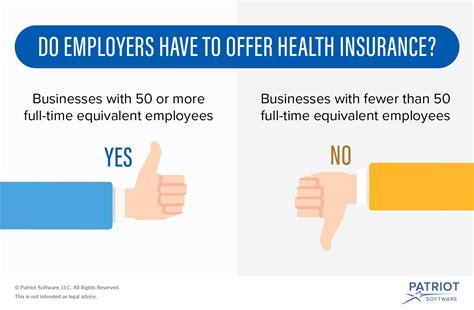Do Employers Have To Provide Medical Insurance

In many countries, including the United States, the question of whether employers are obligated to provide medical insurance to their employees is a significant aspect of labor and employment laws. The availability and accessibility of health coverage have profound implications for workers' well-being and financial stability. This comprehensive article delves into the legal landscape surrounding employer-provided medical insurance, exploring the rights and responsibilities of both employers and employees in various jurisdictions.
The Legal Framework: A Global Perspective

The requirement for employers to offer medical insurance to their workforce varies greatly across different nations and regions. Let's examine some key examples:
United States
In the U.S., the Affordable Care Act (ACA), commonly known as Obamacare, introduced a mandate for certain employers to provide health insurance coverage to their employees. However, the specifics depend on the size of the business and other factors.
- Large Employers: Businesses with 50 or more full-time equivalent employees are generally subject to the Employer Shared Responsibility Provision. This provision mandates that they offer minimum essential coverage to their full-time employees and their dependents, or face potential penalties.
- Small Employers: For smaller businesses, the ACA provides tax credits to help offset the cost of providing health insurance. These credits are designed to encourage small employers to offer coverage.
European Union
Within the EU, the approach to employer-provided health insurance varies from country to country. While some nations have a strong tradition of employer involvement in healthcare, others rely more on public systems.
- Germany: Employers typically contribute to public health insurance funds, with employees also making contributions. However, for those above a certain income threshold, private insurance is an option.
- France: The French system is a mix of public and private insurance. Employers often provide supplementary private insurance to cover additional healthcare expenses.
- United Kingdom: The National Health Service (NHS) provides universal healthcare coverage. While employers are not legally required to offer health insurance, many choose to provide private plans as an employee benefit.
Asia-Pacific Region
In the Asia-Pacific region, the landscape is diverse, with some countries having robust public healthcare systems and others relying heavily on private insurance.
- Australia: Employers are not legally obligated to provide health insurance. However, private health insurance is common, and some employers offer it as a benefit.
- Singapore: The Medisave scheme, a mandatory savings plan, is used to pay for healthcare expenses. While not a traditional insurance plan, it ensures access to healthcare. Some employers also offer additional insurance benefits.
- Japan: Employers are required to enroll their employees in the national health insurance system. Additionally, many companies offer supplementary private insurance plans.
Factors Influencing Employer Obligations

The legal obligation of employers to provide medical insurance is influenced by a multitude of factors, including:
Country-Specific Laws and Regulations
Each country has its own set of laws and regulations governing employer responsibilities in healthcare. These laws can vary significantly, ranging from mandatory employer contributions to public funds to specific requirements for private insurance coverage.
Industry and Sector Considerations
The industry in which an employer operates can also play a role. Certain industries, such as healthcare or insurance, may have specific regulations or expectations regarding the provision of health coverage.
Employment Contracts and Collective Agreements
Individual employment contracts and collective bargaining agreements can stipulate the terms of health insurance coverage. These agreements may outline the type and extent of coverage an employer is obligated to provide.
Economic and Social Factors
The economic climate and social safety nets of a country can influence the need for employer-provided insurance. In countries with robust public healthcare systems, the pressure on employers to offer private insurance may be reduced.
The Benefits and Challenges of Employer-Provided Insurance
There are both advantages and drawbacks to the practice of employers offering medical insurance to their workforce.
Benefits
- Employee Retention: Offering comprehensive health insurance can be a powerful tool for attracting and retaining top talent, especially in competitive job markets.
- Peace of Mind: Employees with access to medical insurance through their employer often feel more secure, knowing they have coverage in case of health emergencies.
- Cost-Effectiveness: In some cases, employers can negotiate group rates with insurance providers, making coverage more affordable for employees.
Challenges
- Cost Burdens: Providing medical insurance can be a significant expense for employers, particularly for small businesses with limited resources.
- Administrative Overhead: Managing employee health insurance plans requires dedicated resources and administrative expertise.
- Limited Flexibility: Some employees may prefer different insurance plans or have specific needs that aren't met by the employer-provided option.
Comparative Analysis: Public vs. Private Healthcare Systems
The debate over employer-provided insurance often intersects with the broader discussion of public vs. private healthcare systems. Let's explore the key differences and implications:
| Aspect | Public Healthcare Systems | Private Healthcare Systems |
|---|---|---|
| Funding | Primarily funded through taxes and government budgets. | Reliant on insurance premiums, out-of-pocket payments, and employer contributions. |
| Accessibility | Universal access, ensuring coverage for all citizens. | May have varying levels of accessibility, depending on income and employment status. |
| Cost | Generally lower costs for individuals, as expenses are spread across the population. | Can be more expensive, especially for those without employer-provided insurance. |
| Choice of Providers | Often restricted to a network of approved healthcare providers. | May offer a wider range of choices, including specialized providers. |
| Waiting Times | Can have longer waiting times for non-emergency procedures. | Typically offers quicker access to services and treatments. |

The Future of Employer-Provided Medical Insurance

As healthcare systems and employment landscapes continue to evolve, the role of employers in providing medical insurance is likely to undergo further changes. Here are some potential future developments:
Shift Towards Flexible Benefits
Employers may increasingly offer flexible benefits packages, allowing employees to choose the insurance plans that best suit their needs. This could involve a mix of public and private options.
Integration of Digital Health Solutions
The integration of digital health technologies, such as telemedicine and health apps, could become a standard part of employer-provided insurance packages, offering convenience and cost savings.
Emphasis on Preventive Care
There may be a growing focus on preventive healthcare measures, with employers incentivizing employees to adopt healthier lifestyles and providing coverage for preventive services.
Global Talent Competition
In a globalized job market, the availability of medical insurance could become a key factor in attracting international talent. Employers may need to enhance their benefits packages to remain competitive.
Expanding Coverage for Gig Workers
As the gig economy continues to grow, there may be increased pressure on employers to provide insurance coverage for this workforce, which often lacks traditional employment benefits.
Frequently Asked Questions
Are there any exceptions to the employer mandate for providing medical insurance in the U.S.?
+Yes, there are exceptions. Religious organizations and certain types of small businesses may be exempt from the employer mandate. Additionally, there are specific rules for nonprofit organizations and certain types of government employers.
<div class="faq-item">
<div class="faq-question">
<h3>How do employers typically choose the health insurance plan for their employees in the U.S.?</h3>
<span class="faq-toggle">+</span>
</div>
<div class="faq-answer">
<p>Employers often work with insurance brokers or directly with insurance companies to select plans that meet the needs of their workforce. Factors like cost, coverage, and employee preferences are considered.</p>
</div>
</div>
<div class="faq-item">
<div class="faq-question">
<h3>Are there any countries where employers are not legally obligated to provide any form of health coverage?</h3>
<span class="faq-toggle">+</span>
</div>
<div class="faq-answer">
<p>Yes, there are countries where healthcare is primarily funded and managed by the government, and employers are not legally required to provide additional coverage. For example, in countries like the United Kingdom and Canada, the national healthcare system covers most medical expenses.</p>
</div>
</div>
<div class="faq-item">
<div class="faq-question">
<h3>Can employees choose their own health insurance plan if their employer provides coverage?</h3>
<span class="faq-toggle">+</span>
</div>
<div class="faq-answer">
<p>It depends on the employer's policy and the healthcare system in the country. In some cases, employees may have limited choices within the employer's selected plan. However, in countries with more flexible healthcare systems, employees may have the option to choose their own private insurance plan and seek reimbursement from their employer.</p>
</div>
</div>
<div class="faq-item">
<div class="faq-question">
<h3>What are some common challenges faced by employers when providing medical insurance to their employees globally?</h3>
<span class="faq-toggle">+</span>
</div>
<div class="faq-answer">
<p>Challenges can include navigating different healthcare systems and regulations in multiple countries, managing costs effectively, and ensuring that the insurance plan meets the diverse needs of a multinational workforce.</p>
</div>
</div>



